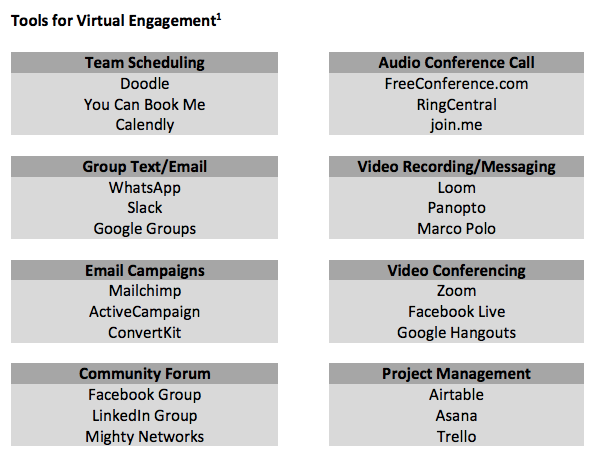How to Connect and Engage with Your Volunteers Remotely

Posted in News Story
By Luisa Boyarski, Ph.D.
April 7, 2020
Dr. Luisa Boyarski is Associate Director of the Center for Public and Nonprofit Leadership and teaches Volunteer Management in the Nonprofit Management Executive Certificate Program.
During this time of hyper change, it is critical for our organizations to focus on what’s essential. Often times, volunteering is considered non-essential, especially when the programs in which volunteers are engaged—visiting patients, tutoring students, guiding museum patrons, etc.—are put on hold due to social distancing guidelines.
Data shows that the volunteers who give the most time are typically older, a demographic that is also vulnerable to the coronavirus. Another reason to limit any in-person volunteer opportunities.
Yet, we cannot ignore our volunteers now and hope they will be ready to re-join us months later when social distancing ends and our programs restart. Volunteering provides purpose and affinity connections for individuals, that is needed now more than ever—for both our volunteers and our staff. In fact, research has found that participation in voluntary services is significantly predictive of better mental and physical health, life satisfaction, self-esteem, and happiness. Finally, we should not forget to consider our organization’s core values and how they relate to our commitment to our volunteers.
Whether your nonprofit has offered virtual volunteering options before, now is the perfect time to pilot new engagement opportunities. I spoke with Valeri Smith at Armed Services Arts Partnership (ASAP) and Lorna Campbell Clarke at Volunteer Fairfax to learn about the steps that their organizations are taking to pivot to remote volunteering.
1) Establish Consistent Communications with Your Volunteers
Consistent communications with your volunteers can help you build and maintain trust, even during times of uncertainty. During this time of constant change, it is recommended that you communicate with volunteers at least once a week. Try to communicate with them on the same days and times, so they know when to expect to hear from you. Make sure the communications include meaningful information, but they can also be fun.
Val, with ASAP shared that their communications with volunteers has “definitely been more frequent than in the past. We used to do just a general email every week, but when things were changing so quickly, we included volunteers on almost every email we sent out, which was probably 2-3 times last week. Our more engaged volunteers are definitely getting more communication about their virtual projects to ensure feedback and follow up.”
If possible, vary the ways that you communicate with your volunteers. Consider group video or conference call discussions. Find ways to re-establish the close connections that you had when you were able to meet in person.
2) Ask Volunteers for Their Input
It is important to meet your volunteers where they are now. Ask them about their availability and limitations. Lorna with Volunteer Fairfax notes that some of the volunteers they are hearing from are a bit frustrated. “There are some volunteers who have been with us for years and some that are new to volunteering. We have a retired and senior volunteer program, RSVP, for whom volunteering is how they get out and socialize. There are also some people that have court-mandated volunteer hours to fulfil. So, there are many different engagement levels of volunteers. But now, all populations are vulnerable. Without virtual opportunities, volunteers cannot ‘work from home.’ So, they are feeling a bit undervalued.” However, because these volunteers provide essential services to nonprofit organizations that are serving our community, they are the best people to ask for input as we pivot in today’s climate.
Val was also concerned about making sure ASAP’s volunteers still felt valued. She shared that “we have had to get really creative with how we keep volunteers engaged because we don’t want them to feel like they’re not needed anymore or that there are no opportunities for them. I think it’s easy to think about the participants and partners and board members and everybody else and then the volunteers just kind of fall to the side. But we want to make sure that they’re as important as everyone else and their wellbeing is part of the wellbeing of our general community.”
Sometimes nonprofit staff can get very attached to “the way we have always done it.” To break out of that mindset, consider asking volunteers to help you think creatively about new opportunities for engagement. At ASAP, volunteers suggested that they could lead virtual workshopping sessions for current students and alumni, to provide a space for them to share and get feedback on their artform, whether it’s comedy, storytelling, creative writing, etc. Val reflects that “giving [volunteers] that voice and ownership over the community is really cool.”
3) Pilot New Opportunities
One way to reduce the stress that can come with launching a new volunteer opportunity is to call it a pilot. This helps everyone relax their expectations and also feel like they are part of the process of creating something new. Here are three areas to consider for pilot projects:
- Community Building – Community is a core value of ASAP. To keep their community engaged and active during social distancing, they have asked their alumni volunteers to “check in on people throughout the week to make sure they’re okay, which I think will be, not only a really fun activity for people, but also a really impactful one to make sure that they are helping us keep engaged in the community in such a direct way,” said Val. Additionally, ASAP’s volunteer artist council is leading an effort to develop “arts prompts” to share with their online community via social media. For example, “your prompt today is to use creating writing to tell a story about being outside.”
- Training – Recognizing that not all volunteer managers have the skills to quickly pivot to virtual engagement, Volunteer Fairfax “just introduced a free series of 8 online training webinars for volunteer managers to consider how to engage virtually. Some of the questions that will be addressed are: Is this something anybody can do? Is there some software we need to roll out? Is there a VPN connection we need to have? Having these conversations and considering what next steps to take are critical,” said Lorna. Training is also important for understanding COVID-19. Volunteer Fairfax has a dedicated resource page on its website and is frequently communicating with its volunteers, partners and stakeholders at least twice a week as rules and safety recommendations change.
- Evaluation – In many cases volunteer managers do not have the luxury of “down time” to evaluate their volunteer programs and re-design their volunteer manual and onboarding process. This is the perfect time to take stock and engage your volunteers in helping measure and improve your volunteer programs. There are a number of virtual tools listed below to help manage this work virtually.

Additional articles in this series, Leading in Times of Hyper Change, can be found on our website, Facebook and Twitter.
